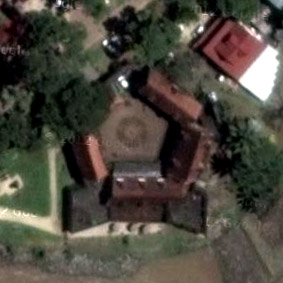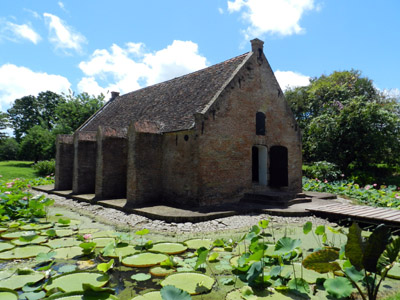 |
Fort New Amsterdam
Paramaribo, Suriname
|
|
 |
Constructed: 1734 - 1747
Used by: Holland, USA
Conflicts in which it participated:
Various Dutch/British clashes of the 18th century;
Second World War
|
Paramaribo is Suriname's capital and largest city, wherein over half of the country's population resides. The Dutch first settled in the region at the beginning of the 17th century, when they started a trading post. The British swooped in and captured this post in 1630, and by 1650 Paramaribo was the capital of the English of Guiana...but there was still a Dutch presence.
Desire for the fertile land of Guiana led to the Dutch and British trading possession of what would become Suriname a number of times after that, but the Treaty of Breda, which ended the Second Anglo-Dutch War (1665-1667), officially ceded the colony to Holland in 1667. The British had to be contented with a crappy plot of land in North America, called New Amsterdam...which would later be renamed the City of New York.
The Society of Suriname, representing the Dutch West India Company, the Aerssens (a prominent Dutch family, who were assumedly making a pile of
|
 |
|
|
 Fort Zeelandia. Red. Shrimpy. Poorly sited. Fort Zeelandia. Red. Shrimpy. Poorly sited. |
 |
dough from plantations in the colony) and the city of Amsterdam, was founded in 1683. This Society was responsible for the construction of Fort New Amsterdam.
Fort Zeelandia, the teeny little starfort we see to the left, was built in 1651 to protect the Dutch trading post. Though it was right at the town of Paramaribo and kept the trading post relatively secure, the ever-industrious French, also busily messing with the Dutch in the New World, just ignored it and raided the plantations directly, a little further up the Suriname River. Well poo, said the Dutch colonial authorities, we really should've built a fort on a better spot.
That better spot was at the confluence of the Suriname River and Commewijne River, not far from the Atlantic Ocean...which is where Fort New Amsterdam would be built. |
|
Construction of Fort New Amsterdam began in 1734, and was immediately beset with problems. Dutch engineers had trouble adapting to local conditions, which completely defeated their building practices. Bricks baked locally proved weak and crumbly, so they had to be shipped from Holland, along with plenty of African slaves to tote them. The wood louse, common in this tropical climate, was voracious, and bridges, walls and just about anything else made of wood tended to instantly deteriorate.
|
When Fort New Amsterdam was finally completed in 1747, it didn't seem to do the Dutch a whole lot of good: On at least two occasions, the fort surrendered without a fight when confronted by the British Navy.
Despite being vastly expensive to maintain and apparently useless as a defensive measure, Fort New Amsterdam continued to be garrisoned through the 19th century. In 1872 some of its barracks were repurposed as a prison: The fort remained Suriname's only prison until 1967, and was used in this role until 1982.
On February 1, 1907, Fort New Amsterdam was made the administrative center for Suriname's
|
 |
Is there any way England and France could have not raided this area? If you had ships, wouldn't you? |
|
Commewijne District: It was no longer an active military installation.
|

One of Fort New Amsterdam's two powder magazines, this one built in 1778 and located in the fort's southwestern bastion. Dutch engineers didn't have much of an appreciation of their colony's climate, so they were never able to effectively store the fort's gunpowder: Damp powder only benefits the enemy. Unless their gunpowder is damp too, but you have to assume it isn't. |
 |
But a well-sited starfort is always in demand, so during the Second World War (1939-1945) the US Army garrisoned Fort New Amsterdam,starting on December 23, 1941. Bauxite, an ore from whence comes aluminum, was being mined in the region, which made Suriname an important strategic asset for the Allied war effort...and South America was most definitely within range of nasty Nazis in U-Boats. Nobody came out to play, however, and the Allies won the war on an unstoppable tide of aluminum cans.
Today, Fort New Amsterdam exists as an "open museum," with plenty of artifacts from the centuries of Dutch rule. Tiny prison cells, old buildings, impressive flora, joyful exhibits about slavery and guns from all eras (including some LARGE ones left by the US Army) are all to be had for an entrance fee of 10 Suriname Dollars (about three bucks). |
|
|
|
|
|
|
 |


